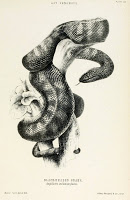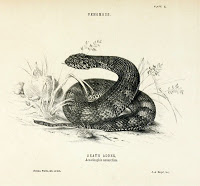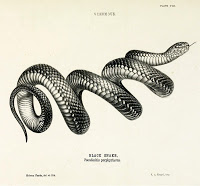Book of the Week: User’s Choice – Snakes!
This week we decided to put the power of choosing the book of the week in the hands of our users. So, using the “Questions” app on our Facebook Page, we asked you which book out of the four options given you would like to see featured on our blog. The options were The Snakes of Australia, British Dragonflies, La Galerie des Oiseaux, and A Book of Whales. The winner?
The Snakes of Australia (1869), by Gerard Krefft!
The aim of this work was to provide a full account, with original descriptions retained wherever possible, of “nearly all the Australian Snakes discovered and recorded up to the year 1868.” The author points out that, by 1854, only “about twenty Australian Snakes were known.” In the succeeding five years, thirty were described, and, by the time of the writing of our book of the week, “seventy species were on record.”
For our post, we decided to highlight a few of the species presented in this book. So, sit back, relax, and read about Australian Snakes in the comfort of your own home (unless, of course, you’re not at home, in which case, the sitting back and relaxing part is completely up to you).

Black-Headed Python (Aspidiotes melanocephalus)
This non-venomous snake can grow up to 7’10”. It is typically “light brown, with a series of darker rings which become indistinct near the sides.” On the underbelly, the Black-Headed Python is “yellowish-white…with a few dark blotches,” while the head and neck are “jet-black above and below.” By the time that this publication was written, very little was known about the snake. “The first specimen which the Museum received was captured by Mr. Rainbird, the well-known collector at Port Denison.”

Common Death Adder (Acanthophis antarcticus)
The Common Death Adder is one of the most venomous land snakes in Australia and the world, with fangs longer than most of Australia’s venomous snakes. While a majority of Death Adders are gray with dark rings about the neck and tip of the tail, some members of the species may be red with dark spots. The species can be found in sandy locations, feeding on frogs, lizards, and small mammals. The author notes that, when threatened, the snake “flattens out its whole body, and darts right and left.” However, as previously thought, it “does not jump, and certainly never jumps backwards.”
Diamond Snake (Morelia spilotes)

This non-venomous snakes has nearly every scale marked with a central single yellow dot. “The largest specimen captured near Sydney, correctly measured, without being stretched, was 10 feet 3 inches long,” though, the author is certain, that specimens measuring over 11 feet no doubt occur, though much more rarely. In nature, this species eats only living mammals, though in captivity it has been observed swallowing already-dead animals. At the time of publication, the author commented that “the species under review are generally infested by various kinds of intestinal worms, including tape-worms, clusters of which have frequently been taken from their stomachs.”
 Redbellied Black Snake (Pseudechis porphyriacus)
Redbellied Black Snake (Pseudechis porphyriacus)
This species is the most common of all of Australia’s venomous snakes. It is “found in low marshy places, is fond of water, dives and swims well, and subsists principally upon frogs, lizards, insects, and other smaller mammalia.” Its highly venous bite can kill “good sized dogs or goats within an hour.” This species rarely grows beyond six feet in length.
This week’s book of the week, The Snakes of Australia (1869), by Gerard Krefft, was contributed by Harvard University, MCZ, Ernst Mayr Library.
To see more Facebook Questions, visit our Questions Page. And be sure to visit us on Facebook or follow us on Twitter (@BioDivLibrary).





Leave a Comment